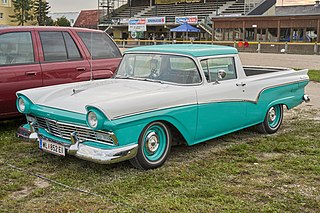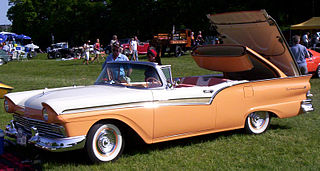Related Research Articles

An axle or axletree is a central shaft for a rotating wheel or gear. On wheeled vehicles, the axle may be fixed to the wheels, rotating with them, or fixed to the vehicle, with the wheels rotating around the axle. In the former case, bearings or bushings are provided at the mounting points where the axle is supported. In the latter case, a bearing or bushing sits inside a central hole in the wheel to allow the wheel or gear to rotate around the axle. Sometimes, especially on bicycles, the latter type axle is referred to as a spindle.

The Ford Torino is an automobile that was produced by Ford for the North American market between 1968 and 1976. It was a competitor in the intermediate market segment. The car was named after the city of Turin, considered "the Italian Detroit". The Torino was initially an upscale variation of the intermediate sized Ford Fairlane. After 1968, the Fairlane name was retained for the base models with lower levels of trim than those models which wore the Torino name. During this time, the Torino was considered a subseries to the Fairlane. By 1970 Torino had become the primary name for Ford's intermediate, and the Fairlane was now a subseries of the Torino. In 1971 the Fairlane name was dropped altogether, and all Ford intermediates were called Torino. This name was one of several originally proposed for the Mustang while in development. The Torino was essentially a twin to the Mercury Montego line.

The Ford Ranchero is a coupe utility that was produced by Ford between 1957 and 1979. Unlike a standard pickup truck, the Ranchero was adapted from a two-door station wagon platform that integrated the cab and cargo bed into the body. A total of 508,355 units were produced during the model's production run. Over its lifespan it was variously derived from full-sized, compact, and intermediate automobiles sold by Ford for the North American market.

Mercury Cougar is a nameplate applied to a diverse series of automobiles sold by the Mercury division of Ford from 1967 to 1997 and from 1999 to 2002. While the nameplate is most commonly associated with two-door coupes, at various times during its production, the Cougar was also marketed as a convertible, four-door sedan, station wagon, and hatchback.

A limited-slip differential (LSD) is a type of differential that allows its two output shafts to rotate at different speeds but limits the maximum difference between the two shafts. Limited-slip differentials are often known by the generic trademark Positraction, a brand name owned by General Motors.

The Ford Fairmont is a front-engine, rear-drive compact car, manufactured by Ford for model years 1978–1983 over a single generation, in two- and four-door sedan, wagon and coupe configurations — alongside its badge engineered Mercury variant, the Zephyr. As the successor of the Ford Maverick, the Fairmont was the third generation of compact sedans sold by Ford in North America, and in contrast to the Maverick, the Fairmont was a completely new design, no longer based on the Ford Falcon.

The Dodge Power Wagon is a four wheel drive medium duty truck that was produced in various model series from 1945 to 1980 by Dodge. The Power Wagon name was revived for the 2005 model year as a four-wheel drive version of the Dodge Ram 2500. As a nameplate, "Power Wagon" continues as a four-wheel drive version of 3/4 ton Ram Trucks 2500 model.

The Hotchkiss drive is a shaft drive form of power transmission. It was the dominant means for front-engine, rear-wheel drive layout cars in the 20th century. The name comes from the French automobile manufacturer Hotchkiss, although other makers, such as Peerless, used similar systems before Hotchkiss.
The Ford C4 is a three-speed, medium-duty automatic transmission introduced on 1964 model year vehicles and produced through 1981. The C4 was designed to be a lighter and simpler replacement for the original Ford-O-Matic two speed transmission being used in smaller, less powerful cars.

The mainstream Ford line of cars grew substantially larger for 1957, a model which lasted through 1959. The Crown Victoria with its flashy chrome "basket handle" was no more, and the acrylic glass-roofed Crown Victoria Skyliner was replaced by a new model, the retracting-roof hardtop Skyliner.

The Ford Motor Company Falcon XY GT is a sports sedan based on the Ford Falcon XY. Released in 1970 by Ford Australia, with the GTHO Phase III released in 1971. Some 1,557 units were produced from September 1970 to December 1971 with 300 GTHO Phase IIIs produced from May 1971 to November 1971. It was the fourth in the initial series of the Ford Falcon GT. A limited number were exported to South Africa, wearing Fairmont GT badging. The Fairmont GT model is starting to increase in value as Falcon GTs become harder to find and buyers beginning to see the Fairmont as a genuine GT.
The 10.5" Corporate 14 Bolt Differential is a heavy duty differential found on many 1973-2013 Chevrolet and GMC trucks and SUVs, as well as certain versions of the Cadillac Escalade. Additionally, this differential is found on Chevrolet Express and GMC Savanna vans produced from 1973 to current day. Debuting in 1973, this differential is a full floating design with a ring gear diameter of 10.5 inches (270 mm). As the name implies, this differential has 14 bolts holding on the differential cover. The ring gear is not held on with 14 bolts, but rather 12. The 14 bolt differential is a popular axle swap option for Jeep Wrangler owners, and is referred to as the "corporate" 14 bolt because of the odd nature of GM's corporate structure in the 1970s.

The fifth-generation Ford Mustang (S197) is a pony car that was manufactured by Ford from 2004 to 2014, at the Flat Rock Assembly Plant in Flat Rock, Michigan. The fifth generation began with the 2005 model year, and received a facelift for the 2010 model year. Originally designed by Sid Ramnarace through late 2001 and finalized in mid-2002, the fifth-generation Mustang's design was previewed by two pre production concept cars that debuted at the 2003 North American International Auto Show. Development began on the S-197 program in 1999 under chief engineer Hau Thai-Tang, shortly after the 1998 launch of "New Edge" SN-95 facelift. From the second half of 1999, design work commenced under Ford design chief, J Mays, and concluded in July 2002 with the design freeze. There have been several variants of the fifth-generation Ford Mustang that include the Mustang GT/California Special, Shelby Mustang, Bullitt Mustang, and Boss 302 Mustang.

The Dana/Spicer Model 60 is an automotive axle manufactured by Dana Holding Corporation and used in OEM pickup and limited passenger car applications by Chevrolet, Dodge, Chrysler, Jeep, Ford and Land Rover. There are front and rear versions of the Dana 60. It can be readily identified by its straight axle tubes, 10 bolt asymmetrical cover, and a "60" cast into the housing. Gross axle weight ratings are often lowered by the vehicle manufacturer for safety and tire reasons. They are also lowered to reduce loads on other powertrain components such as transmissions and transfer cases. Dana 60 Axles are also increasingly swapped into many custom offroad applications to accommodate larger tires and deep compound gearing with locking differentials.
The Dana/Spicer Model 70 is an automotive axle manufactured by Dana Holding Corporation and has been used in OEM heavy duty applications by Chevrolet, Dodge, and Ford. It can be identified by its straight axle tubes, 10 bolt asymmetrical cover, and a "70" cast in to the housing and is visually similar to the Dana 60. The majority of the Dana 70s are rear axles, however Dana 70 front axles do exist. Both front and rear axle variations were first offered in 1957. The Dana 70 is generally regarded to have more strength than a Dana 60 but not as much as a Dana 80. Gross axle weight ratings are often lowered by the vehicle manufacturer for safety and tire reasons.

The Dana/Spicer Model 80 is an automotive axle manufactured by Dana Holding Corporation and has been used in OEM heavy duty applications by Chevrolet, Dodge, and Ford. It can be identified by its straight axle tubes, 10 bolt asymmetrical cover, and a "80" cast into the housing. Dana 80's are made as full floating, rear axles only and are step up in overall strength compared to the Dana 70. 1988 Ford was the first company to use the Dana 80. The Dana 80 has a GAWR up to 11,000 pounds (5,000 kg), however it is common practice among manufacturers to derate Dana 80's. Gross axle weight ratings are lowered by the vehicle manufacturer for safety and tire reasons. The OEM Limited slip differential originally was a "Power Lok" until 1998 when the "Trac Lok" phased it out. Trac Loks were a $350.00 USD option with Ford Super Duty trucks. The Dana 80 Trac Lok is unique being it is a 4 pinion unit, unlike other Dana Trac Lok units with 2 pinions. This was the only rear axle available for the 2nd generation Dodge Ram 3500 trucks.

The Dana/Spicer Model 44 is an automotive axle manufactured by Dana Holding Corporation and is used extensively among automobile manufacturers and in the automotive aftermarket area as well. The Dana 44 was first manufactured in the 1940s and is still being manufactured today, both front and rear axle variants. The Dana 44 has been manufactured as a beam axle and independent suspension for both front and rear axle setups. There are also different variations of the Dana 44. Over a dozen automobile manufacturers have made vehicles that have Dana 44 axles, including Jeep which currently manufactures four-wheel drive vehicles that have both front and rear Dana 44 axles.

The Dana/Spicer Model 35 is an automotive axle manufactured by Dana Holding Corporation since 1985 when American Motors (AMC) sold its axle tooling equipment to Dana. The axle was originally named an AMC-15 when it was first made in 1962. Dana upgraded the axle, and made IFS and Twin Traction Beam front axle variations, as well.

The Sterling 10.5 axle is an automotive axle manufactured by Ford Motor Company at the Sterling Axle Plant in Sterling Heights, MI. It was first used in model year 1985 Ford trucks. The axle was developed to replace the Dana 60 and Dana 70. The Sterling 10.5 axle is currently only made as a full floating axle.
The Ford 8.8 is an automotive axle manufactured by Ford Motor Company at the Sterling Axle Plant in Sterling Heights, MI. It was first used in model year 1983 Ford trucks. The axle was developed to replace the Ford 9-inch axle. This axle is still in production today for a variety of Ford vehicles.
References
- Turner, Steve (1999), "How to Tune and Modify Your Ford 5.0 Liter Mustang, 1979-95", books.google.co.uk, ISBN 978-0-7603-0568-3 , retrieved 22 August 2011,
Ford's 9-inch rear end is so durable it's a wonder Ford stopped making it